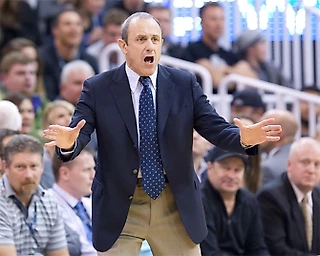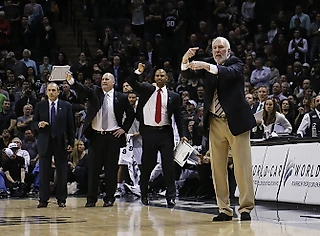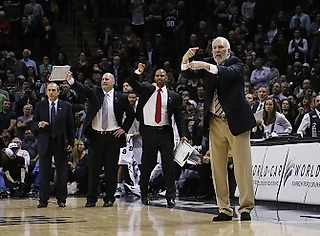Fundamental, not only mental
Messina Online
Besides psychological points that we've already discussed, there are a few more aspects we need to concentrate on to play a good team basketball. First of all, we need to make sure our team has a solid basis of basketball knowledge, the individual and team fundamentals. We can have a hyper-motivated team, very strong psychologically, but we'll lose to a team with lower level of motivation, provided they are stronger fundamentally: in shooting, dribbling and passing. Motivation and mental preparation makes a difference only if there is a solid basis of technical skills.
The team also must be physically ready to perform under pressure. We should always remember that physical preparation, especially in basketball, has two sides: team and individual preparation. In basketball, we have extremely different typology of players: for example, small guards as opposed to strong and powerful big men.
As for technical preparation, we've already discussed how to select players and mentioned the qualities to look for.
There are two general ideas behind a team playing good basketball. The first one is to select players who can adjust and follow your vision of basketball. This might be a source of a huge competitive advantage. If you have a coach with profound knowledge and good personality, you can select players for him to let him develop his personal vision of the game. Though, it's getting more and more difficult these days, because of the limitations of the market. Many teams are fighting to get a few good players.
The second idea is to select the best players available, according to your evaluation of their technical, physical and psychological qualities, and then adjust your general vision to the specific abilities of the players you have. This idea is very important as it's extremely difficult to get the players that would perfectly fit in the system due to increased market competition.
I consider adjusting the system to the players available as another source of an enormous competitive advantage you could get. Somebody else might insist on always finding players that would fit in their personal vision. That is the way it might work for them.
I had an opportunity to coach a lot of great players who were totally different in many ways. Let me give you an example. We won the first national championship with Virtus Knorr Bologna with Roberto Brunamonti, old time leader of the club, and Sasha Danilovic at guards. Then, in 1998, we had Antoine Rigaudeau and Sasha Danilovic. In 2001, we had Marco Jaric and Emmanuel Ginobili. In Treviso in 2003, we had Tyus Edney and Trajan Langdon. Here we have J.R. Holden, Trajan Langdon, Theodoros Papaloukas and David Vanterpool. They are all different. Somebody is faster, somebody likes to control the ball more, somebody needs more screens, somebody needs more space and less screens.
In basketball, if you use a lot of screens, the game's pace is slower as compared to playing without screens and using a lot of movement without the ball like cutting and splitting. If there is more contact, usually the game slows down. So, we needed to adjust our system to the individual abilities of our players. For example, we could not press full-court with Rigaudeau and Danilovic, as they are not suited for that kind of defense. We could not allow many defensive switches with J.R. Holden or Tyus Edney, as they are quick, but not powerful, and if we switch a lot, they'll end up playing in low post against bigger players.
To sum up, I always tried to suggest my club to get the best players available who put team interests ahead of their individual performance. Then, I adapted our technical organization of the team so they could use their strengths in our system. I don't want them to adjust to the system. It's more important for me that the players understand basketball philosophy, which is very simple. We need to think team first.
Second, we need to play good defense as basketball is started with it. Teaching methods that start with offense are not realistic. In the game, you need to get the ball first. You have to organize your defense to recover the ball by either forcing a mistake or rebounding. Only when you have the ball, you can decide what kind of offense you are going to run.
Third, on offense, we need to pass the ball to find an open man. It's not about four guys working to get one player open and give the ball to him. It's about team basketball, about passing the ball to take advantage by finding an open man who will shoot. The higher number of complete players we have, the better team basketball we can play and the more balanced our game is. To be competitive at highest level you need to have 5 men who are real danger for the defense.
Many people think that at our level the emphasis is on giving the team tactical instructions. Playing combination #2 instead of #3. Coaches who come to our practices and follow our games are always surprised that we work a lot on team things: like 4 on 4, 5 on 5 with the main focus on the fundamentals. Everything gets down to how well you execute the individual fundamentals. Even during the time-outs, sometimes we don't suggest any specific combination, we just give our players technical instructions on spacing and timing. These two instructions of spacing and timing are the essence of our everyday work.
The timing concept is very simple. Timing is all about doing something in the sync with other players. In basketball, while one action is finishing, the other one is starting. Simple example: to catch the pass you should make a step towards the ball. If you wait for the ball, it gives your opponents the chance to either interfere with your action or reset the defense so you find yourself playing 1 on 1 in static position. When our players dribble, they are making the pass simultaneously while finishing the dribble. We don't finish the dribble, look around and then pass. Any fan watching the game can easily understand whether there is continuity in actions. When you see the things are rolling one after another, it means you have good execution in basketball.
Spacing is all about the distance between the players on court. The concept of spacing in defense is trying to cover as much space as you can in order to have at least one player who can defend his man and disturb another player. Spacing in offense is about trying to prevent the situation where one opponent can defend your two players or can help his teammate and recover his position. Offensively, you must stay at a certain distance, not too far and not too close, so it would be very difficult for him to recover.
We work hard to help our players to act within the same concept of spacing and timing.
Of course, these two instructions are used at every level, from junior to Euroleague. What makes the difference is the perfection in execution. The key is to have a good execution at higher speed. Usually, if your execution is slow, it's easier for the opponents to interfere. The great teams are those who do all the fundamentals at high speed and in balance. Young coaches often focus on obtaining from their players quickness in the execution. Personally, I think that coach must look for the body balance first.
Once you're capable to find your body balance while executing the fundamentals, you can look for a higher speed. If you're looking for a higher speed with young players in the first place, they always go off balance. They always make mistakes.
Body balance is one of the most important qualities for the players to have, if they want to play at a higher level. I prefer to have a little bit slower player, but with good balance, always in control with his body. Like Trajan Langdon. J.R. Holden, on the other hand, is an example of a player who is balanced and quick.
The good news is that you can work on body balance. Our athletic trainer Gosha Artemiev is very good at helping our players to do exercises to improve body balance. Body balance is something most young big men don't have. They usually play straight up on their legs. Bending the knees is one of the biggest problems for them.
To develop great basketball players, you should train them to play with contact, physical intensity and pressure, and evaluate them accordingly. I'm talking even about conditioning trainings. This is what basketball is all about.
In basketball, evaluating track and field abilities and working on them is not enough. Moreover, this kind of evaluation and training gives you wrong perspective. We need to evaluate all kind of abilities with the ball and with the contact.
For example, you can have a player who runs very fast, but he becomes very slow with the ball. Or you can have a player who jumps very high, but under physical contact from his opponent, he can't jump that high because he loses his body balance. Or he may be very good at running, but has problems to coordinate his body with his quickness while catching a long pass. In all these examples, we have a great track and field athlete or a great volleyball player who will have hard time in basketball. This is why it's tricky to evaluate basketball players under the standards that are commonly applied in track and field.
Offensively, our game is much simpler that many people think. On offense, we try to take advantage of our opponent, to get open for 1 second to shoot or pass. It makes opponent's defense work to stop me, and it makes them leave somebody else open. Now, if I can find another open man with a pass, we keep the advantage and, sooner or later in 24 seconds, we'll have a completely free shot.
You can keep the advantage only with a pass. Many players can create the advantage, thanks to their jump, quickness or receiving a screen. The defense reacts to take away this advantage. This is why players like Papaloukas or Vanterpool are so good. They make an extra pass to keep the advantage. This is why CSKA, Panathinaikos, Maccabi are great teams. Most of the players in these teams can make an extra pass. The pass that gives you the opportunity to keep the advantage is the key to the offensive game.
Defensively, you try to steal the advantage with the aggressiveness, trapping, denying, or with passive defense that challenges the opponents to shoot from outside. On defense, you need to steal the advantage from the other team. Here, anticipation is the key.





Thank you very much for your time.
Thank you for the time you devote to us!!
We really admire you!))